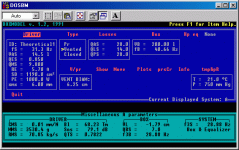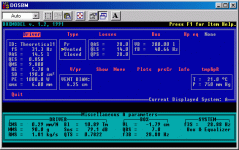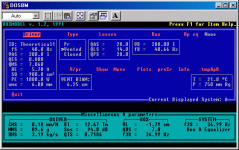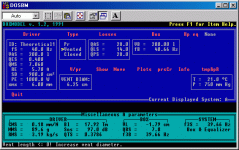Please help me which could perform better between the two drivers & why (explained) for pro use,
Thiele Para of driver 1- 18" Driver - 8Ohms
FS- 31.38
VAS - 14.44 L
Qes - 0.849
Qms - 9.809
Qts - 0.781
SD - 190 in^3
Inductance - 1mH
Power Handling - 800W
Thiele Para of driver 2 - 18" Driver - 8Ohms
FS - 23.17
VAS - 118.3 L
Qes - 0.408
Qms - 5.538
Qts - 0.380
SD - 170 in^3
Inductance - 2mH
Power Handling - 600W
As simulated in WINISD the first driver shows its best to be used in sealed, but can i use it as ported, if yes what would be the disadvantages of using the driver recommended for sealed, is used as ported enclosure.
The first driver is tested in a 2.8Cu ft sealed enclosure, it has a very good clean tight bass
Thiele Para of driver 1- 18" Driver - 8Ohms
FS- 31.38
VAS - 14.44 L
Qes - 0.849
Qms - 9.809
Qts - 0.781
SD - 190 in^3
Inductance - 1mH
Power Handling - 800W
Thiele Para of driver 2 - 18" Driver - 8Ohms
FS - 23.17
VAS - 118.3 L
Qes - 0.408
Qms - 5.538
Qts - 0.380
SD - 170 in^3
Inductance - 2mH
Power Handling - 600W
As simulated in WINISD the first driver shows its best to be used in sealed, but can i use it as ported, if yes what would be the disadvantages of using the driver recommended for sealed, is used as ported enclosure.
The first driver is tested in a 2.8Cu ft sealed enclosure, it has a very good clean tight bass
Resonance Frequency (Fs), Q of the resonance peak (Qts) and Volume of Air Equivalent to the Suspension Compliance (Vas) are the key parameters to how it will sound. Linear Excursion (Xmax), Surface Area (Sd) and power will give you an indication of how loud it will go.
The first drive unit I would guess is cheap as Qts is high. There is no way it will work in a vented box. I am certain that the value you have given for Vas is wrong as it's far too low for that size of drive unit.
The second drive unit can be used in either a vented or sealed box as Qts is about a medium value. I'd choose a vented cabinet as it would get a bit deeper and louder, but the box will be a bit larger and harder to make. Fs is low so bass will be fairly deep. Again though, Vas looks on the low side.
I would recommend measuring the parameters yourself once you get the drive unit as they can differ a bit because of tolerances and you can't always trust how well the manufacturer measured them.
The first drive unit I would guess is cheap as Qts is high. There is no way it will work in a vented box. I am certain that the value you have given for Vas is wrong as it's far too low for that size of drive unit.
The second drive unit can be used in either a vented or sealed box as Qts is about a medium value. I'd choose a vented cabinet as it would get a bit deeper and louder, but the box will be a bit larger and harder to make. Fs is low so bass will be fairly deep. Again though, Vas looks on the low side.
I would recommend measuring the parameters yourself once you get the drive unit as they can differ a bit because of tolerances and you can't always trust how well the manufacturer measured them.
I HAVE READ THAT ONE SHOULD AT LEAST RUN THE DRIVER FOR HALF AN HOUR TO FREE THE SUSPENSION BEFORE MEASURING THE DRIVER.
The parameters given are tested by me with SW. The magnet design for the first driver is a T yoke design with fem, 1.7T in the gap, how can we get the BL.
The parameters given are tested by me with SW. The magnet design for the first driver is a T yoke design with fem, 1.7T in the gap, how can we get the BL.
To break in, half an hour is not enough IMO, a few hours is needed.
I think your method of measurement of calculation of Vas is going wrong somewhere. Both those figures are too low, one massively so.
You can measure Bl by applying an accurately known weight to the cone and measuring how much current is needed to bring the cone back up to the original position, then plugging this data into a formula. I'd concentrate on getting your basic parameters right first though.
I think your method of measurement of calculation of Vas is going wrong somewhere. Both those figures are too low, one massively so.
You can measure Bl by applying an accurately known weight to the cone and measuring how much current is needed to bring the cone back up to the original position, then plugging this data into a formula. I'd concentrate on getting your basic parameters right first though.
Ashok its made by me, with a T-Yoke and 30mm deep magnet structure to get good Xmax, Coil design- 35mm length and achieved a lower inductance of 1mH, and tested it with 600W, continious load for 2Hours.
I have tested it in my sealed test box of 2.8Cu ft, its performance is ultimate, but i dont know how good is the performance by knowing the thiele para (like in previous message by richie00boy a high value of QTS is not good). IS IT THAT A HIGHER Total Q VALUE IS NOT GOOD, and I thought higher Q is better.
The gap is also very tightly set, and as per my knowledge it's should definately perform in its best.
Can you please help me how to interpret about the design by the thiele para's.
i.e. - What effects the VAS, Qms, Qes,
I have tested it in my sealed test box of 2.8Cu ft, its performance is ultimate, but i dont know how good is the performance by knowing the thiele para (like in previous message by richie00boy a high value of QTS is not good). IS IT THAT A HIGHER Total Q VALUE IS NOT GOOD, and I thought higher Q is better.
The gap is also very tightly set, and as per my knowledge it's should definately perform in its best.
Can you please help me how to interpret about the design by the thiele para's.
i.e. - What effects the VAS, Qms, Qes,
High Qts is bed because it indicates poor inherent damping within the driver. So high Qes is poor electrical damping and high Qms is poor mechanical damping.
You might like to read through the papers by Thiele and Small on my website www.readresearch.co.uk in the 'papers' section.
You might like to read through the papers by Thiele and Small on my website www.readresearch.co.uk in the 'papers' section.
Sonu:
You're basically asking for a course in loudspeaker building.
For the engineering minded, the basic parameters and what affects them are explained in the papers by Aussies Richard Small and Neville Thiele-these are the famous Thiele-Small papers from which we get the famous Thiele-Small parameters.
As stated previously, Richie00boy has these papers downloadable for your convenience at his wonderful website:
http://www.readresearch.co.uk/
If you want to know how the Thiele-small parameters work together, an excellent explanation is given by David Weems in his excellent book Designing, Testing and Building Loudspeakers. It is written for the complete novice to get him started, but the explanations are great.
You're basically asking for a course in loudspeaker building.
For the engineering minded, the basic parameters and what affects them are explained in the papers by Aussies Richard Small and Neville Thiele-these are the famous Thiele-Small papers from which we get the famous Thiele-Small parameters.
As stated previously, Richie00boy has these papers downloadable for your convenience at his wonderful website:
http://www.readresearch.co.uk/
If you want to know how the Thiele-small parameters work together, an excellent explanation is given by David Weems in his excellent book Designing, Testing and Building Loudspeakers. It is written for the complete novice to get him started, but the explanations are great.
Sonu:
Don't know what to tell you. The link should work.
Clicking the "Papers" section on Rich's home page should lead you to the following page:
http://www.readresearch.co.uk/HTML/papers.htm
I felt it was preferable to give Rich's home page, instead of the specific page, because Rich has all sorts of useful other stuff on his site you might wish to explore.
Don't know what to tell you. The link should work.
Clicking the "Papers" section on Rich's home page should lead you to the following page:
http://www.readresearch.co.uk/HTML/papers.htm
I felt it was preferable to give Rich's home page, instead of the specific page, because Rich has all sorts of useful other stuff on his site you might wish to explore.
Sonu:
A trememndous help seeing the relationship between the parameters is BoxModel, DOS freeware by Bullock and White. Available here:
http://www.hal-pc.org/~bwhitejr/
Caution: Ignore the Transmission Line section of this freeware, Bullock himself admitted it was inaccurate. But the rest of it is fine.
It might take a few minutes to learn to use the arrow keys and Enter key to input data, but it will be worth it.
Using this software, for instance, I can tell right off that speaker number 1 is way off on it's Vas. Why? Because DOS BoxModel tells me that if I input all these parameters, this is what I get:
Bl = 68.23 Tm
That never happens. The highest Tm's you usually see are 25 or so. So this is way off.
A trememndous help seeing the relationship between the parameters is BoxModel, DOS freeware by Bullock and White. Available here:
http://www.hal-pc.org/~bwhitejr/
Caution: Ignore the Transmission Line section of this freeware, Bullock himself admitted it was inaccurate. But the rest of it is fine.
It might take a few minutes to learn to use the arrow keys and Enter key to input data, but it will be worth it.
Using this software, for instance, I can tell right off that speaker number 1 is way off on it's Vas. Why? Because DOS BoxModel tells me that if I input all these parameters, this is what I get:
Bl = 68.23 Tm
That never happens. The highest Tm's you usually see are 25 or so. So this is way off.
By the way, I think I see where you went wrong.
Your Vas is given in liters-metric. Most programs use metric as the default. Dammit.
However, your Sd you listed as 190 square inches. Inches are now used mostly in North America. I think you took the 190 square inches and filled it in a formula as 190 square centimeters. An Sd that small would probably yield a Vas of 14.5 liters.
190 square inches equals 1187, (or 1190), square centimeters. Try putting Sd =1190 square centimeters in your calculations and see how it comes out.
Your Vas is given in liters-metric. Most programs use metric as the default. Dammit.
However, your Sd you listed as 190 square inches. Inches are now used mostly in North America. I think you took the 190 square inches and filled it in a formula as 190 square centimeters. An Sd that small would probably yield a Vas of 14.5 liters.
190 square inches equals 1187, (or 1190), square centimeters. Try putting Sd =1190 square centimeters in your calculations and see how it comes out.
454Casull:
Thanks. That is quite high.
Now that you mention it, I think I might have come across a few Bl's of 28 or 29 or so, so I shouldn't be so surprised at one of 32.
I think you will agree, though, that 32 is only somewhat above 25, while a Bl of 68 is pretty far removed from what one is likely to ever come across.
Thanks. That is quite high.
Now that you mention it, I think I might have come across a few Bl's of 28 or 29 or so, so I shouldn't be so surprised at one of 32.
I think you will agree, though, that 32 is only somewhat above 25, while a Bl of 68 is pretty far removed from what one is likely to ever come across.
Sonu:
Just to illustrate, here is a screenshot of BoxModel using the parameters you gave us. forget about PE or excursion-for our purposes they don't affect what we are doing right now.
You didn't give Re, for an 8 ohm driver it is useally around 5.7 ohm, that's what I put.
For the dark blue area, we are only interested in the box under "Driver". The other boes have to do with enclosure measurements, which we don't care about right now. The parameters written under "Driver" are the parameters of the driver, in free air-no enclosure.
The way this program works is, we fill in our driver's parameters inthe "Driver" area inthe dark blue. Then the program calculates the other parameters and lists them in the light green area.
We cannot directly change what is written in the light green area. However, we can change what is written in the "Drivers" area in the dark blue, and that will change what is written in the light green area.
As you can see, if we fill in 1190 square entimeters-the equivalent of 190 square inches-the Bl goes up to 68. That is almost impossibly high.
Just to illustrate, here is a screenshot of BoxModel using the parameters you gave us. forget about PE or excursion-for our purposes they don't affect what we are doing right now.
You didn't give Re, for an 8 ohm driver it is useally around 5.7 ohm, that's what I put.
For the dark blue area, we are only interested in the box under "Driver". The other boes have to do with enclosure measurements, which we don't care about right now. The parameters written under "Driver" are the parameters of the driver, in free air-no enclosure.
The way this program works is, we fill in our driver's parameters inthe "Driver" area inthe dark blue. Then the program calculates the other parameters and lists them in the light green area.
We cannot directly change what is written in the light green area. However, we can change what is written in the "Drivers" area in the dark blue, and that will change what is written in the light green area.
As you can see, if we fill in 1190 square entimeters-the equivalent of 190 square inches-the Bl goes up to 68. That is almost impossibly high.
Attachments
Now, if we fill in an Sd of 190 square centimeters, we arrive at a Tm of 10.8-a very normal Bl value. This is why I think you accidntally filled in 190 square centimeters for your Sd value, when it is actually 190 square inches-or 1190 square centimenters.
Attachments
sonu said:....a high value of QTS [0.78] is not good). IS IT THAT A HIGHER Total Q VALUE IS NOT GOOD, and I thought higher Q is better.
Depends. If this driver was to be used in a dipole construction, the Qts would be considered ideal. Used in a box-probably too high, unless the box volume is at least as large, or larger, than the Vas.
sonu said:i.e. - What effects the VAS, Qms, Qes,
A lot of things affect each other, but let me illustrate something.
Suppose you have an 8 ohm, 15 inch speaker with an Fs of 40 Hz, a Vas of 200 liters, and a Qts of 0.72. You would like to lower the Qts.
The formula for Qts is:
Qts = (Qes X Qms) / (Qes + Qms)
Now, if you do the math, you are going to find that for most values of Qes and Qms you are likely to run into, Qts and Qes are pretty close. So if you can get Qes to where you want it, Qts will not be far behind.
So, here are the parameters of the 15 inch speaker with the "high" Qts of 0.72, which we would like to lower. Note the Bl value and the Sns, (sensitivity) as well.
Attachments
Now, we increase the Bl by putting a bigger magnet on the speaker. Assuming the voice coil stays the same, adding a bigger magnet will do that. This cuts the Qes in half, which cuts the Qts almost in half.
As the chart indicates below, we just took the Qts down to about 0.38-a pretty normal value for a Qts, and one which allows you to use a vented tuning, if you wish.
We also increased the sensitivity by 3 dB-pretty nice.
We do all this, but the Fs and the Vas stay the same!
There are other ways to increase the Bl besides using a bigger magnet, but a bigger magnet is one way to do it.
As the chart indicates below, we just took the Qts down to about 0.38-a pretty normal value for a Qts, and one which allows you to use a vented tuning, if you wish.
We also increased the sensitivity by 3 dB-pretty nice.
We do all this, but the Fs and the Vas stay the same!
There are other ways to increase the Bl besides using a bigger magnet, but a bigger magnet is one way to do it.
Attachments
- Status
- This old topic is closed. If you want to reopen this topic, contact a moderator using the "Report Post" button.
- Home
- Loudspeakers
- Multi-Way
- sealed vs. ported



